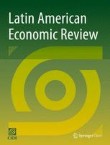Frontiers in the economics of crime: lessons for Latin America and the Caribbean
Crime and violence generate many distortions in the allocation of private and public resources and engender economic and social costs that hinder development. In Latin America and the Caribbean, which is the m...
